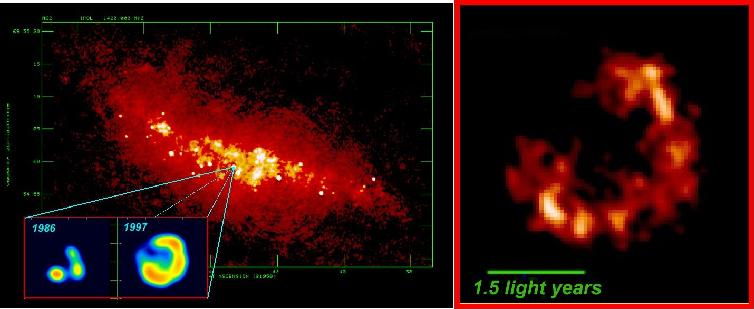
AN EARTH-SIZED TELESCOPE OBSERVES EXPLODING STARS IN ANOTHER GALAXY

(Left) A MERLIN+VLA radio image of the central part of the nearby galaxy Messier 82 (M82) showing some of the supernova remnants present. Inset are images of the youngest remnant observed in 1986 and 1997, obtained by combining data from European radio telescopes which shows clear expansion over the 11 years. (Right) A highly detailed image, observed in November 1998, of the same remnant obtained from a 'World Array' of telescopes showing for the first time, the complex interaction of the ejected material with its surroundings.
UK radio astronomers have used a telescope the size of the earth to peer into the heart of a nearby galaxy. What they found was the scattered remains of stars that tore themselves apart in catastrophic explosions.
The astronomers are led by Dr. Alan Pedlar of the Jodrell Bank Observatory (University of Manchester), Dr. Tom Muxlow of the MERLIN/VLBI National Facility (also at Jodrell Bank) and Dr. Karen Wills of Sheffield University. Using a collection of 20 radio telescopes spaced right around the earth, the team have produced an image of unprecedented detail of the galaxy known as M82. They found bright remnants of exploding stars and, comparing them with images taken many years ago, have found these shells of gas are expanding at up to 20,000 km every second. The youngest object they found to be only 35 years old.
The technique of combining the signals from radio telescopes spaced across continents results in very detailed pictures of the sky. The UK astronomers have performed their observations with one of the largest ever collections of telescopes. It's as if they had a telescope 12,000 km across. Their maps of the sky are so detailed that they can see objects only 0.2 light years wide at a distance of 10 million light years. The pictures are 30 times clearer than can be obtained with the famous Hubble Space Telescope, and as Dr. Mike Garrett (another member of the observing team) from the Joint Institute for VLBI in Europe said. "This is equivalent to being able to read a newspaper in London from Holland!"
The astronomer's target was the nearby starburst galaxy M82. These galaxies, containing many billions of stars, are disturbed and are undergoing a rapid phase of star creation. Most new stars are quite small and live a long time like our local example, the Sun. But a small number of new stars are huge and evolve very rapidly - living for only a few million years or so. As Dr. Phil Diamond, director of the MERLIN/VLBI National Facility put it "These giant stars live fast and die young". So, paradoxically, the signature of such starformation is the explosion of massive stars.
When such large stars die, they do so in spectacular fashion. They blow themselves apart in a titanic explosion called a 'supernova'. The remnants of these supernovae are often expanding shell-like clouds of gas shining brightly in radio waves. Understanding such supernova remnants in regions where stars are being made is particularly important as it is thought that most galaxies, including our own, passed through this phase many billions of years ago when the Universe was young. However, the supernova remnants cannot easily be seen in visible light - even with the Hubble space telescope - because starburst galaxies contain a lot of obscuring dust. But, as Dr. Tom Muxlow explained, "Radio waves are unaffected by this dust and we are able to look right into the violent centre of the galaxy". The spectacular deaths of the massive stars in the centre of Messier 82, can be used to gain insights into the whole starburst phenomenon.
In this galaxy astronomers have seen, for the first time, the detailed evolution of the expanding fireball from a supernova explosion. And these distant and violent events have a strange twist in their tail. Dr. Karen Wills explained; "It is the death-throes of these massive stars which create the heavy elements from which life is made". All the material which makes up the Earth, the rocky planets and moons in our Solar System and our bodies was made in massive stars and scattered by such explosions in the early history of the Milky Way.
In September the team of astronomers reported results from observations using 8 telescopes distributed across Europe. Their images confirmed the shell-like nature of the supernova remnants and, by comparing the images with data taken in 1986, it was possible to deduce both the age and expansion velocity of the youngest of the remnants. The results of the latest observations, one of the largest radio astronomy experiments yet performed, will be presented at the December 10th meeting of the Royal Astronomical Society by PhD student, and newest member of the team, Andy McDonald.
The shell-like structures of even the smallest of the objects in M82 are clearly visible in the astronomer's images. The astronomers hope to measure directly the expansion and slowing of the remnants as they interact and mix with the surrounding medium. As Dr. Alan Pedlar pointed out "M82 is an ideal laboratory for studying these remnants, since, unlike similar objects in the Milky Way, those in M82 are all essentially at the same distance and can now be measured with the same level of detail as remnants in our own galaxy".